The Best Plastic-Free Baby-Led Weaning Plates
Starting baby-led weaning (BLW) with our own little one was both exciting and a little overwhelming. Like most new parents, we wanted to give our baby the best start possible with nutrient-dense foods, lots of sensory exploration, and the freedom to learn at their own pace. But what we didn’t expect was how quickly we’d become hyper-aware of the materials our baby was eating from.
BLW is messy, joyful, and, if you choose the right materials, healthier for your little one and the planet. Traditional plastic plates can leach microplastics and additives, especially when exposed to warm foods, scrubbing, or frequent dishwashing. Thankfully, there are excellent plastic-free options that are durable, safe, and designed with BLW in mind.
If you’re starting your own BLW journey (or searching for better alternatives to plastic), getting familiar with the strengths and limitations of each material makes choosing the right plate so much easier. Below, we break down the four most popular plastic-free options (bamboo, stainless steel, porcelain, and tempered glass), so you know exactly what to expect from each one.
From there, we’ll share our top five recommended baby-led weaning plates based on real-world use, durability, safety, and parent-approved practicality.
Material Comparison: Bamboo vs. Stainless Steel vs. Porcelain vs. Glass
Bamboo
Bamboo was one of the first materials we tried during baby led weaning because it felt warm, lightweight, and natural. Those qualities really do make a difference with a baby who is just learning to self-feed. In our experience, the lightness made it easy for our baby to explore, lift, and move the plate, while the natural texture gave it a more grounded, less “toy-like” feel compared to colorful plastic.
Practically speaking, bamboo plates are naturally antibacterial, don’t leach chemicals, and come in beautiful divided designs that work well for BLW. But we quickly learned that they require more gentle care. They held up better with hand-washing only, drying immediately, and steering clear of long exposure to very wet or acidic foods. Over time, ours showed light staining and a few cracks, which is normal for bamboo but worth knowing upfront.
Before doing our research, we assumed anything labeled “bamboo” was automatically natural and plastic-free. But after reading way too many product labels, we learned that many bamboo plates marketed for babies aren’t actually solid bamboo, but bamboo fiber mixed with melamine plastic or other plasticizers. All that to say, you should know the difference if you are in the market for bamboo products.
- Solid bamboo plates are carved from whole bamboo. These are the safer, more natural options. Look for items that are explicitly labeled as solid bamboo or carved bamboo, not bamboo fiber.
- Bamboo-fiber melamine plates are ground-up bamboo particles bound together with melamine-formaldehyde resin, a type of plastic used to make them hard, smooth, and colorful. These melamine-based plates often feel lightweight and look sleek, which makes them appealing, but they’re not plastic-free.
Pros
- Lightweight and easy for babies to handle
- Does not leach chemicals or microplastics (melamine-free versions)
- Naturally antibacterial and biodegradable
- Beautiful, warm, earthy look
Cons
- Can crack, warp, or stain over time
- Not dishwasher-safe or microwave-safe
- Needs more gentle care (hand-washing, no soaking)
- Not ideal for very wet or acidic foods over long periods
- Some versions are made with melamine, a synthetic resin
Stainless Steel
Stainless steel quickly became a workhorse in our BLW routine. From a personal perspective, it was the one plate we never had to worry about with no staining, no cracking, no warping, and no complicated care routine. It handled spaghetti, berries, citrus, and yogurt without absorbing a single color or smell. And the fact that it’s 100% plastic-free gave us peace of mind with every meal.
Functionally, stainless steel is one of the safest and most durable materials you can use. It’s lightweight but strong, dishwasher-safe, non-porous, and resistant to bacteria. The biggest caveats we experienced were the lack of suction (our baby absolutely took advantage of this) and the inevitable metallic clang when a spoon banged against it, which our baby loved, and we tolerated.
Pros
- Virtually unbreakable
- Dishwasher-safe and long-lasting
- No coatings, plastics, or glues
- Lightweight yet sturdy
Cons
- No suction base unless paired with silicone
- Can be noisy when dropped
- Conducts heat so hot foods can warm the plate
Porcelain
We didn’t bring porcelain into the mix until our baby was older and a little more coordinated, but once we did, we really appreciated its clean, smooth surface and how well it handled messy meals. Porcelain doesn’t stain, doesn’t absorb odors, and feels like “real dinnerware,” which made mealtime calmer and less chaotic.
On the practical side, porcelain is naturally non-toxic and non-porous, and it holds temperature well so cool things stay cool and warm foods stay warm. It’s also microwave and dishwasher-safe, which added some welcome convenience. The main concern is breakability. Ours survived plenty of bumps, but porcelain is still porcelain, so we reserved it for calmer meals and the later days when our baby was no longer in a throwing phase.
Advantages
- Naturally non-toxic, non-porous, and plastic-free
- Microwave-safe and dishwasher-safe
- Doesn’t retain odors or stains
- Smooth, attractive aesthetic
Disadvantages
- Breakable if dropped
- Heavier for small hands
- Less options for divided BLW-style designs
Tempered Glass
Tempered glass ended up being the biggest pleasant surprise. We originally underestimated its durability, but brands like Duralex truly hold up to daily use. For us, glass became the go-to for foods that stained bamboo or made stainless steel too warm. It always cleaned beautifully, and we liked knowing that the plate was fully inert with no coatings, no dyes, and no chemical concerns whatsoever.
Practically, tempered glass is one of the safest materials for food contact and is incredibly easy to clean. It’s dishwasher, microwave, freezer, and oven safe, which made it surprisingly flexible. But like porcelain, it’s still breakable under the right (or wrong) conditions. We used it more often once our baby stopped immediately testing gravity with every meal.
Advantages
- Completely non-toxic and non-porous
- Dishwasher, microwave, freezer, and oven safe
- Extremely durable when tempered
- Long lifespan and fully recyclable
Disadvantages
- Can still break if dropped hard
- Heavier and less suited for babies who throw plates
- Typically no suction base
Considerations about Silicone Components
While better than plastic, silicone still isn’t ideal from a longevity and renewability standpoint. Below are some key considerations.
Silicone isn’t truly plastic-free
Even though it’s made from silica (sand), silicone is still a synthetic polymer. It behaves more like plastic than like natural materials such as bamboo, stainless steel, glass, or porcelain.
It can break down under high heat or repeated wear
Higher-quality silicone is more stable, but low-grade silicone can degrade over time, especially when exposed to high heat, harsh detergents, UV light, or oils and acidic foods. When silicone wears down, it can release siloxanes, which are under growing scrutiny for potential health impacts.
Some silicone contains fillers
Not all silicone is created equal. Cheaper silicone products often contain plastic fillers that reduce durability and purity. These fillers can’t be seen with the naked eye. Squeeze test: if it turns white when pinched or twisted, it usually contains fillers.
Difficult to verify purity
Manufacturers don’t always disclose whether silicone is “food-grade,” “platinum-cured,” or mixed with additives. Without reputable sourcing or transparency, you can’t be fully sure what’s in it.
Food-grade silicone is silicone that’s been approved for contact with food. This means it meets basic safety standards for leaching, temperature stability, and chemical content. Food-grade is still a broad category. It guarantees a minimum standard, but it does not guarantee purity.
Platinum-cured silicone uses platinum (yes, the metal) as the curing catalyst during production. This creates a much cleaner chemical reaction and results in significantly purer, more stable silicone. Platinum-cured silicone is the standard used in medical devices, bakery mats, high-end baby products, bottle nipples, and pacifiers because it produces a cleaner, more consistent material. Platinum-cured silicone is the safest, most stable form of silicone available for food and baby products.
Silicone isn’t easily recyclable
While marketed as “recyclable,” silicone can’t be processed by most municipal recycling programs. It often ends up in landfills where it can take hundreds of years to break down.
Silicone can retain odors and stains
Unlike truly inert materials like glass or stainless steel, silicone is semi-porous. It can absorb smells, oils, and food pigments over time, especially with warm or fatty foods.
Not biodegradable
Silicone doesn’t biodegrade or compost. While it’s more durable than plastic, it still contributes to long-term waste if disposed of.
Our Top 5 Plastic-Free Baby-Led Weaning Plates
Below are five standout options that minimize plastic exposure without sacrificing function.
Quick Takeaways
| Brand | Format / Material | Best For | Pros | Cons |
|---|---|---|---|---|
| Elk & Friends Porcelain Plate w/ Silicone Sleeve | Porcelain plate wrapped in removable silicone sleeve | Parents who want a non-plastic eating surface but still need anti-slip protection and modern design | • Food touches only porcelain • Silicone sleeve adds grip + drop protection • Dishwasher & microwave safe • Divided options | • Heavier than bamboo & stainless • Silicone component • Can chip if dropped hard |
| Ahimsa Stainless Steel Divided Plate | 100% medical-grade stainless steel | Parents who want the most durable, long-lasting, truly plastic-free solution | • Completely plastic-free • Ultra-durable and unbreakable • Dishwasher safe • Designed by a pediatrician • Lightweight but sturdy • Divided options | • No suction base • Can be noisy if dropped • Conducts heat, may warm with hot foods |
| Munchkin Bambou Bamboo Suction Plate | Natural bamboo plate + silicone suction base | Early BLW starters, especially babies who toss or slide plates | • Lightweight and easy to handle • Strong suction • Divided options • Aesthetic, warm look | • Hand-wash only • Bamboo can stain or crack over time • Silicone component • Not microwave safe |
| Avanchy Bamboo Suction Plate | Organic bamboo plate + silicone suction ring | Parents who want an eco-friendly, stylish bamboo look with dependable suction | • Lightweight and easy to handle • Strong suction • Organic bamboo • Divided options • Smooth, polished aesthetic | • Hand-wash only • Bamboo can stain or crack over time • Silicone component • Not microwave safe |
| Beaba Duralex Tempered Glass Meal Set | Fully tempered glass plate, bowl, and cup | Parents who want 100% plastic-free contact between food and plate material | • Completely inert, non-toxic glass • Dishwasher, microwave, freezer safe • Highly durable for glass • Fully recyclable | • Can still break under force • Heavier and easier for babies to throw • Not divided |
1. Elk and Friends – Divided Porcelain Suction Plate
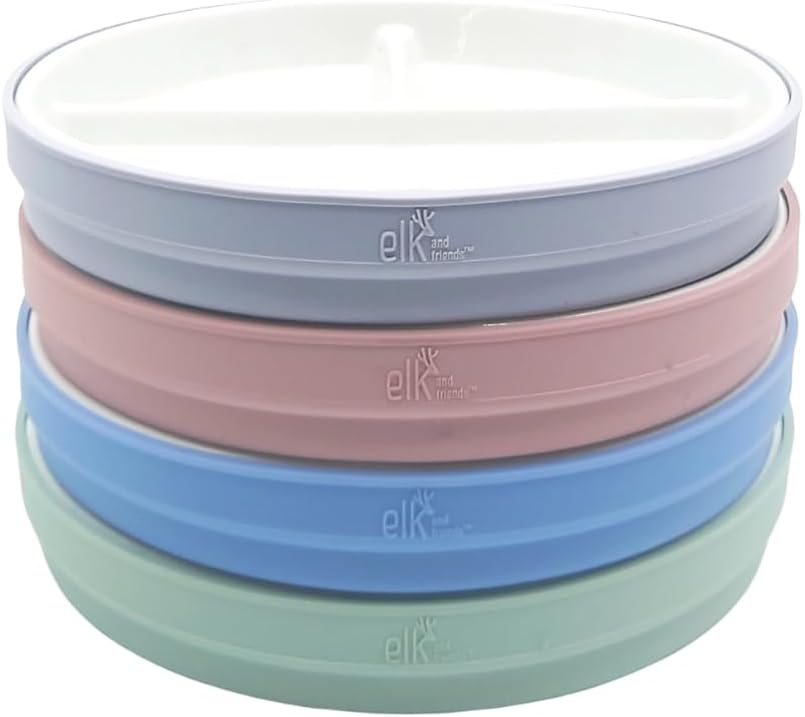
Best for: Parents wanting non-toxic porcelain but with drop protection.
If you’re drawn to clean, minimalist style but still want a practical plate for baby-led weaning, Elk & Friends delivers. This option uses a porcelain plate (so food contacts a non-plastic surface) wrapped in a removable silicone sleeve for added slip-resistance. The look is modern and upscale, but still functional for baby or toddler meals. It strikes a sweet balance between design and performance.
Pros
- Food only contacts glass
- Silicone sleeve protects from drops
- Dishwasher and microwave safe
- Divided sections great for BLW
Cons
- Heavier than bamboo or stainless steel
- Needs supervision with plate-throwers
- Silicone component
2. Ahimsa – Stainless Steel Divided Weaning Plate
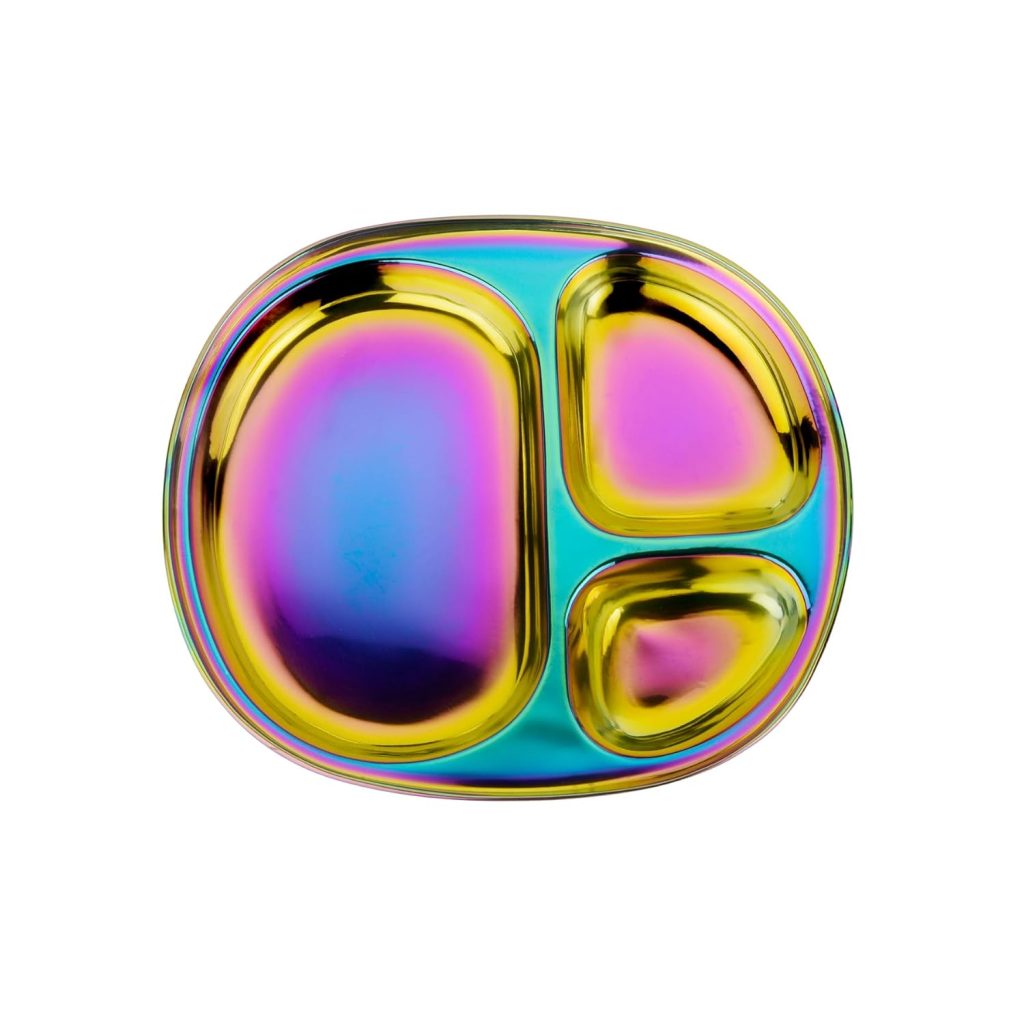
Best for: Parents wanting completely plastic-free, medical-grade stainless steel.
For parents who want a truly “set it and forget it” plastic-free plate, Ahimsa is a standout. Designed by a pediatrician, this stainless steel plate is built for durability, zero coatings, and repeated use, even as your child grows. It’s a no-frills, high-integrity choice for families who prioritize safety and simplicity over suction bells and whistles.
Pros
- 100% stainless steel. No coatings, dyes, silicone
- Dishwasher-safe and ultra-durable
- Divided compartments sized for BLW
- Lightweight but sturdy
Cons
- No suction base (may slide on slick surfaces)
- Can be loud if dropped
- Higher price point
3. Munchkin Bambou – Bamboo Divided Suction Plate
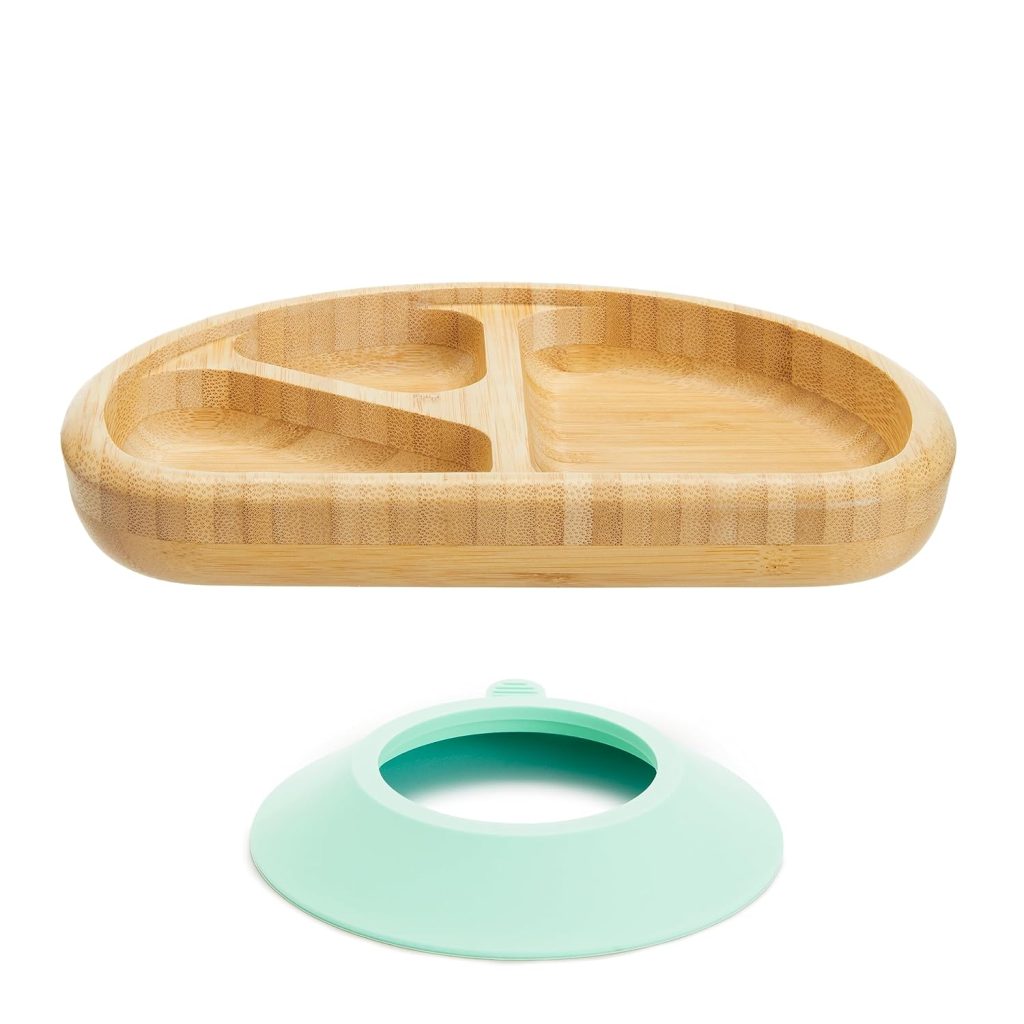
Best for: Parents wanting an eco-friendly bamboo option with suction support.
If you love a warm, natural aesthetic and a plate that sticks to the high chair tray during mealtime, the Munchkin Bambou is a great pick. Made from renewable bamboo and featuring a strong suction base, it blends sustainability with toddler-friendly performance. Ideal for messier first BLW attempts when you want something light and resilient, but still not plastic.
Pros
- Made from real, sustainably sourced bamboo
- Lightweight and baby or toddler-friendly
- Suction base helps reduce mess
- Divided options for BLW
- Warm, natural aesthetic
Cons
- Hand-wash only
- Silicone component
- Can stain or crack over time
- Not microwave safe
- Not dishwasher safe
4. Avanchy – Bamboo Divided Suction Plate
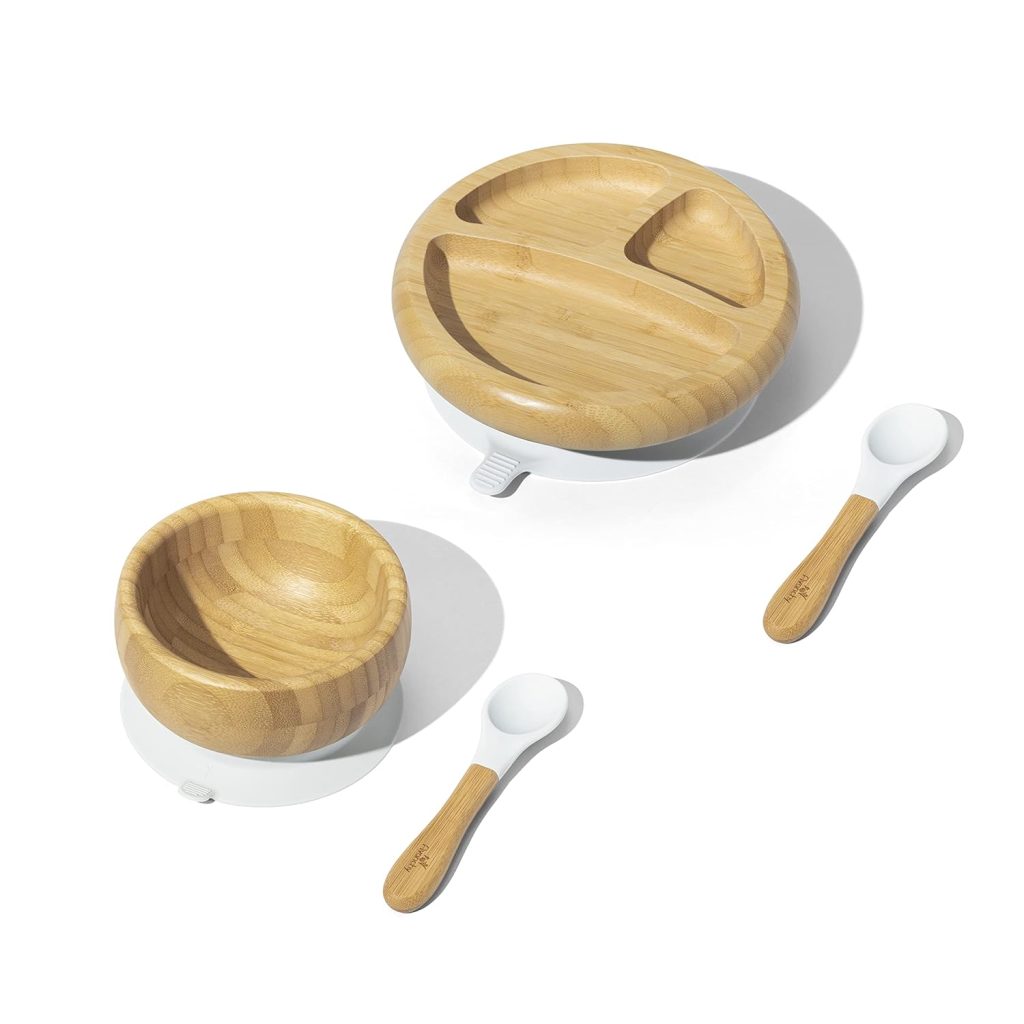
Best for: Parents wanting a more stylish bamboo option with suction support.
Similar in spirit to the Munchkin option, Avanchy brings a refined bamboo plate with suction ring designed for growing appetites. The design is a little more upscale and curated, making it a strong pick if aesthetics matter and you still want an eco-friendly, toddler-safe plate with suction power.
Pros
- Made from organic bamboo
- Strong suction ring
- Divided options for BLW
- Lightweight and baby or toddler-friendly
- Smooth, polished look
Cons
- Hand-wash only
- Silicone component
- Can stain or crack over time
- Not microwave safe
- Not dishwasher safe
5. Beaba Duralex – Tempered Glass Suction Meal Set
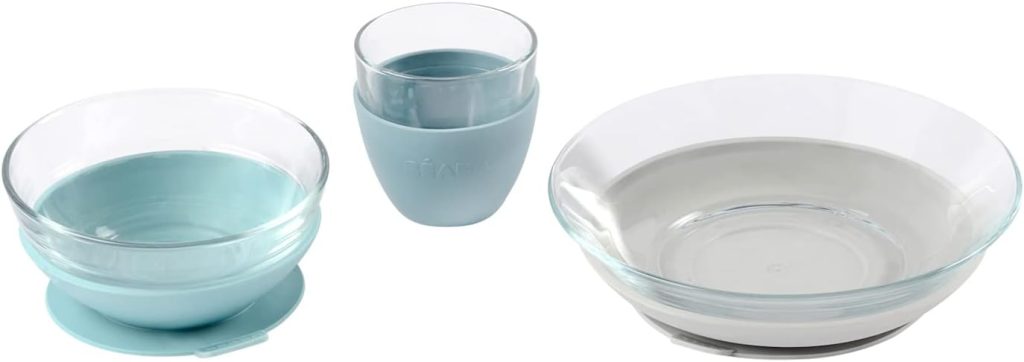
Best for: Parents wanting a long-lasting solution with unmatched durability for glass.
If your goal is zero plastic contact between baby and plate material, a tempered glass plate from Beaba is a top-tier option. While it is heavier, the food touches pure glass, which is non-porous, chemical-free, and built to last. Unless it is dropped on a hard surface, expect this option to last throughout childhood. The suction is helpful for the younger years, but can be removed for older babies or toddlers who’ve outgrown fling-and-drop phases.
Pros
- 100% glass (minus silicone suction)
- Extremely durable, chip-resistant tempered construction
- If broken, glassware shatters into small chunks rather than shards, reducing the risk of injury
- Dishwasher, freezer, and microwave safe
- Great for older babies and toddlers
Cons
- Can break with a high fall
- Not divided into sections
- Heavier than stainless steel
Final Thoughts: Which Material Should You Choose?
For newborn BLW starters who throw plates:
Stainless steel is the safest and most durable.
For parents who value natural, warm aesthetics:
Bamboo is a great choice to start. Just be mindful of care needs.
For minimizing plastic contact with food:
Glass or Porcelain ensures food touches a fully inert material.
For longevity and zero plastic whatsoever:
Stainless steel wins again.
Whichever route you choose, switching to a plastic-free weaning plate is one of the simplest ways to reduce microplastic exposure during your baby’s early years, while also reducing waste and investing in materials that last.

